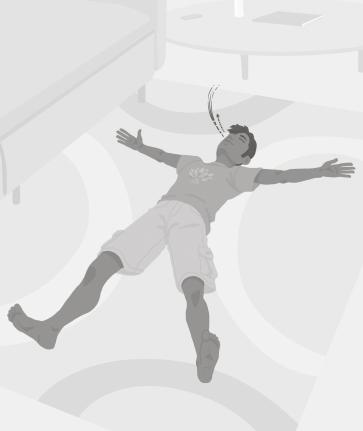chapter five
Chill, Homies
If you’re like me, your home is your sanctuary, where you can relax, rest, and nestle in comfort—right? Except, there’s that little issue of needing to maintain your cozy nest. Washing dishes and vacuuming dog hair can feel so mundane. I dread ironing.
Here are a few ways to make chores less of a chore and convert them into movement that matters for the body and mind. And, because I’m a big supporter of giving yourself downtime, too, I’ve included a few things to help us homebodies relax after household tasks, dealing with challenging kids, or finally getting home after an exhausting day running around town. So… chill, homies. Care for home sweet home and care for yourself, too.
In this chapter:
Dive Right In
■ strengthen
■ empower
■ inspire
■ refresh
You are procrastinating. You have a bunch of stuff to do around the house, and chores have never been your strong suit. Assume the position of an adventuresome diver, ready to take the plunge and get submerged in efficiency. Think of how good you’ll feel when you eventually come up for air.
Happy-Go-Yoga
1. Stand with your feet together, toes and heels touching.
2. Place your hands on your hips.
3. Hinge at your hips and fold your upper body over to make a ninety-degree L-shape (as you fold, firm your navel, like you are just trying to keep your belly lifted into your body as you descend).
4. Try to lengthen your spine by reaching the middle of your chest and the top of your head in the opposite direction of your rear end.
5. Reach backward with your hands toward your hips and imagine you have wings.
6. Feel your outer hips wrapping around toward your inner thighs and your inner thighs rolling toward each other and backward through your legs.
Option A: With your palms facing down, stretch your hands back past your hips.
Option B: Keep everything the way it is, including the hands reaching back (option A), and rise up onto the balls of your feet.
About Dive Right In
Dive Right In is based on a non-traditional pose, Diver’s Pose, and the very traditional, Half Forward Fold (Ardha Uttanasana: ARD-uh OOT-uh-NAH-suh-nuh), both of which help yogis prepare for more intricate and challenging poses that require balance and core strength. As you fold yourself in half, your core is fired up to protect your back, and your back muscles are activated to stabilize and lengthen your spine. Your feet, calves, and ankles are working together to keep you in balance as your weight shifts, while muscles in your rear end secure the connection between your upper and lower body. Meanwhile, your shoulders get a stretch as you reach back with your fingers, opening up your chest a little. So don’t hesitate. Just dive right in. Even if the list of chores is really long, once you’re done, you’ll surface, breathe, and be ready to dive right into something much more fun.
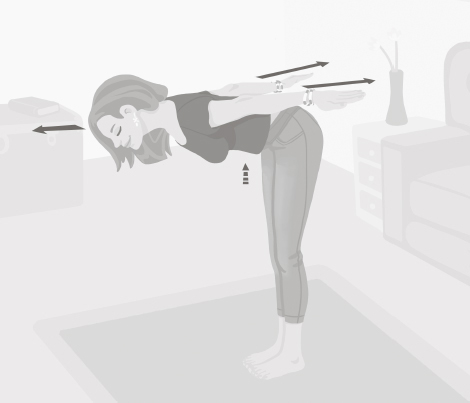
Dish It
■ strengthen
■ empower
■ balance
A pile of dirty dishes in the sink is never fun, but you’ve got to get through them. Do this pose to help your tummy digest your meal with ease and clear the sink, too.
Happy-Go-Yoga
1. Stand at the sink with your feet separated about hip width apart for stability.
2. As you stand close to the counter and sink area, let your belly lean into the sink counter, but not too much.
3. Inhale through the nose and inflate your belly (you should feel it pressing against the counter a little).
4. Exhale and draw the entire belly into your body and away from the sink counter, without moving anything else.
5. Still on your exhale, imagine lifting your belly button up and in, as if you’re trying to tuck it up under your ribs and lock up your midsection.
6. Try to stay relaxed as you suspend your breath.
7. Take a big inhale to release the lock, and exhale normally to release everything.
8. Repeat steps 3 through 7 several times while you scrub the dishes.
About Dish It
Dish It strengthens the abdominal muscles and massages the organs around the middle of the body. It’s a lighter version of a pretty intense yoga lock, or seal, called Abdominal Lock (Uddiyana Bandha: OO-dee-YAH-nah BAHN-duh), meant to improve digestion and elimination. Dish It also helps increase circulation, support digestion, and promotes a strong metabolism. Plus, anything that helps the core supports the lower back, too. In an ancient Hatha yoga text called the Gheranda Samhita, it’s said this lock “destroys decay and death.” Like I said, Dish It is a lighter version, so let’s just call it Happy-Go-Yoga’s way of fitting stealth abdominal toning and internal cleansing into the mix as you clean up the kitchen.
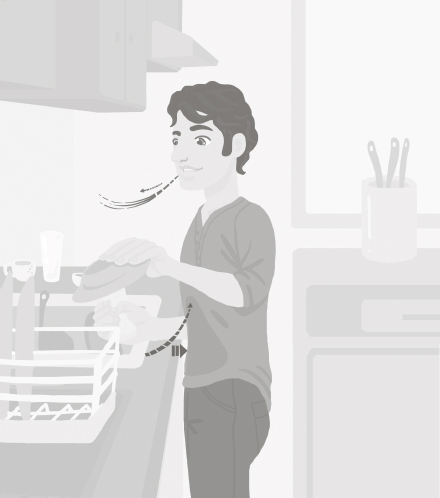
Surf It
■ strengthen
■ brighten
■ balance
■ refresh
Dust bunnies multiply and float across the floor, and you notice that the carpet is oddly… crunchy. You can no longer put off vacuuming. Drag. If you put a little rolling wave motion into your movement as you roll the vacuum across the floor, then it’s a little more like a day at the beach. (Okay, maybe that’s an exaggeration, but it’s better than just vacuuming.)
Happy-Go-Yoga
1. Place your feet about two or three feet apart while holding on to the vacuum with your hand (the vacuum will be slightly in front of you and to the side, to begin).
2. Step solidly into both feet to feel your center of gravity—strong in the middle.
3. As you pull the vacuum closer to you, shift backward and bend your back knee, putting most of your weight on the leg that’s farthest away from the vacuum).
4. If you can, while solidly weighted on the back leg, lift the toes of your front foot and flex them toward your ankle. Dig the heel into the floor a little more firmly for stability.
5. As you push the vacuum away from you, press your back foot into the floor, lengthen that back leg, and use the strength of the back leg to propel your weight forward, into your front leg and over your front foot. Bend your front knee to accommodate the motion.
6. Repeat steps 3 through 5 and get a sense of a smooth rocking motion as you slide the vacuum back and forth.
About Surf It
Think of waves rolling ashore and back out to sea: There’s a calming, rocking quality to them. You can bring a little tranquility to the noisy task of vacuuming with Surf It, which is a standing version of Pose of the War God (Skandasana: skahn-DAHSS-uh-nuh), moving into a light Warrior II (Virabhadrasana II: VEER-uh-buh-DRAH-suh-nuh). This pose helps steady your core and strengthen your leg muscles, which help us stand and move through our day. Surf It also stretches the hamstrings and calves while helping you work on your balance. Hopefully, as you dream of surfing the waves in a tropical place, vacuuming will be more of a breeze.
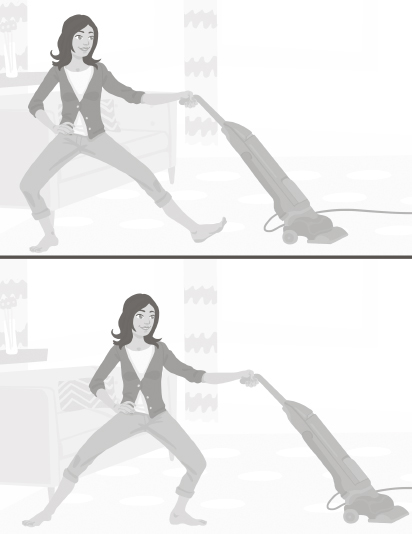
Garden with the Gods
■ strengthen
■ empower
■ inspire
■ brighten
Your normal green thumb efforts need a little inspiration as you dig up weeds and nourish the soil. It’s looking a little wimpy and sad in the garden, and those newly planted seeds need to sprout. Divine intervention couldn’t hurt. Might be time to Garden with the Gods.
Happy-Go-Yoga
1. In the garden, on a soft surface like soil or grass, kneel with your toes underneath your rear end.
2. Two options for toes:
Option A, Tuck: Tuck your toes under and let the balls of your feet touch the ground, like you’re making toe prints in the earth, to stretch out the arches of your feet.
Option B, Untuck: Let your toenails touch the earth to stretch the tops of your feet.
3. Reach your arms up overhead and interlace your fingers, pressing your palms together. (Try to lengthen your arms as much as possible toward the sky, your upper arms framing your ears.)
4. Keeping the fingers interlaced and the palms touching, release your thumb and index finger and press them together while pointing them skyward, as if you could send out a thunderbolt from the tips of your index fingers with your concentration and energy.
5. Keep sitting deeply toward the earth; as you inhale, reach higher toward the sky without lifting your rear.
6. Keep the lift, and exhale while sending energy into the roots of everything in your garden and into your feet as they help nourish your efforts to grow.
7. Repeat steps 5 and 6 until you and your garden are sufficiently inspired (or your thunderbolt arms need a break).
About Garden with the Gods
Set aside your shovel for a sec, in favor of a thunderbolt, the weapon of the sky gods. Garden with the Gods is based on yoga’s Thunderbolt Pose (Vajrasana: vaj-RAH-suh-nuh). It helps strengthen your calf muscles while stretching the arches or the tops of your feet. It can also help improve your posture as you try to center your spine over your pelvis and your pelvis over your feet. You’ll also feel this pose in your shoulders, biceps, and upper back the longer you keep them firm and skyward. Garden with the Gods can help encourage meditation and deep breathing, which will likely help you as you finish your weeding.
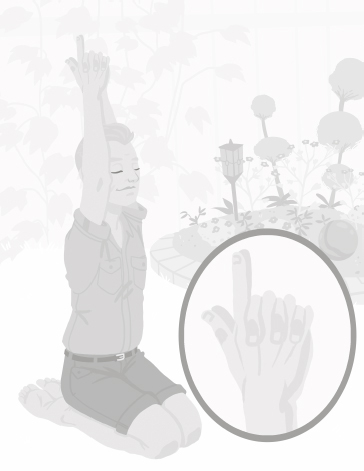
Laundry Lift
■ strengthen
■ balance
Is it your imagination or is this laundry basket a lot heavier than the last time you did a load? Are your arms just tired? Lift your laundry using the bigger muscles in your lower body for more power and stability.
Happy-Go-Yoga
1. Look at your laundry basket on the floor and separate your feet in one of two ways: just more than shoulder width apart if your basket is on the narrow side, or wider than shoulder width apart if the basket is a little bigger.
2. Bend your knees and squat down deeply to bring your rear end closer to the floor, but keep your chest up as much as possible. If you can, squat deeper.
3. Feel your center of gravity at your core and breathe deeply.
4. Inhale to prepare as you grab hold of the basket, keeping your heart above the level of your rear end.
5. As you exhale, from the strength of your legs, press your feet into the ground to rise up with the laundry basket.
6. Proceed to the washing machine and refocus your efforts on not mixing the colors and whites.
About Laundry Lift
Many people hurt their backs doing everyday tasks, especially lifting, by asking vulnerable parts of the body to do too much. Let your stronger parts do the heavy lifting, as they were designed to do. At the same time, strengthen some key muscle groups. Happy-Go-Yoga’s Laundry Lift draws upon the benefits of Goddess Pose, or Utkata Konasana (oot-KAH-tuh koh-NAHSS-uh-nuh), excellent for building strength in the legs. At the same time, using Laundry Lift to pick up a heavy load—or anything else—will help protect your back, too. (Watch Olympic weight lifters. They use their legs!) Not a bad deal to have all of that know-how to lift things, plus clean clothes. Now, breathe in the scent of clean laundry, and try to meditate while you sort the socks.
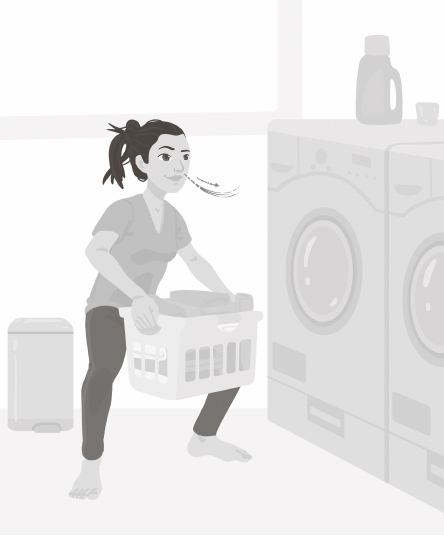
Superhero
■ inspire
■ strengthen
■ relax
■ love
Cleaning, cooking, and helping with homework… it’s all done! You got through all your tasks with speed, agility, and power! Seriously, you feel like a superhero. Let this pose rescue your tired body and spirit, then get some well-deserved rest and relaxation, recharging for the next mission.
Happy-Go-Yoga
1. On a soft surface, such as an evenly folded blanket, sit on your heels, with your shins on the floor.
2. Let the tops of your feet and toenails touch the floor.
To support your knees: Place an evenly folded blanket between the backs of your thighs and your calves.
To support your ankles: Place part of a blanket between your ankles and the floor, rolling or folding it to make a long, small pillow.
3. Keep your knees on the floor, close together as you stay seated on your heels.
4. Lean back and walk your hands back so they are under your shoulders and your chest faces upward.
5. Let your fingers point outward (your right hand will turn clockwise and your left hand will turn counterclockwise).
6. Lift your heart toward the ceiling.
7. Press into the floor to help lift your heart and widen the space across the front of your chest.
8. If your neck feels fine, you might try to lean your head back and open the space of your throat.
9. Breathe deeply for three to five breaths before you come down.
10. Repeat steps 6 through 9 twice more, if you like.
About Superhero
Superhero is the Happy-Go-Yoga combo of two classic yoga poses: Hero Pose (Virasana: veer-AH-suh-nuh) and Upward Plank Pose (Purvottanasana: pur-voh-tuh-NAH-suh-nuh). Just like you multitask at home, Superhero accomplishes a bunch of things at the same time. It stretches your thighs, knees, arches, and ankles after all that hard work at home. It’s also uplifting for your heart as you stretch the fronts of your shoulders and chest muscles, while relieving tummy tension to improve digestion and dissolving hip tightness. If this pose is practiced regularly, some benefits might include reducing high blood pressure and relieving asthma symptoms. Clearly, this pose has some extraordinary powers to help us. Call upon it anytime you need assistance!
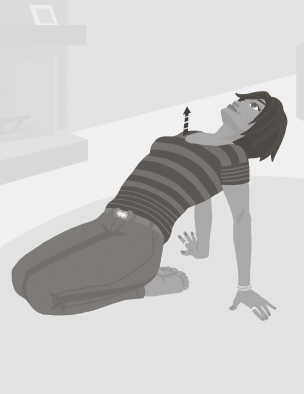
Towel Glide
■ relieve
■ relax
That hot shower did you some good. You’re a lot more relaxed, but a little more relief for your neck and shoulders would be so welcome. Take advantage of your body’s warm temperature post-shower to give yourself a good stretch and a deeper chill-out. Dry off with your towel, then use it for this pose.
Happy-Go-Yoga
1. Dry off after the shower. Put on a soft, loose shirt to keep your body warm.
2. Hold the towel in front of you, lengthwise (and bunch it up in your hands to hold it). Your hands should be about three to four feet apart.
3. Keep holding on to the towel and lengthen your arms in front of you, as straight as you can (but don’t lock out or hyperextend your elbows).
4. Keeping the towel taut, inhale and raise your arms and the towel above your head.
5. Exhale, and reach behind you with the towel, keeping the towel taut and your arms lengthened. Let your shoulders drop down your back.
6. Inhale to raise your long arms, with taut towel, above your head again.
7. Exhale to bring the towel back in front of you.
8. Repeat steps 4 through 7 as desired.
About Towel Glide
Happy-Go-Yoga’s Towel Glide is an adaptation of a beloved yoga strap method to benefit some big muscle groups that support arm and upper-body movements every single day. As you bring the towel above your head while holding it taut, you get a stretch on the underside of the arms and in the rib cage muscles. As you bring the towel behind your back and continue to tug it taut, you’ll melt away tension in the shoulders and chest. The entire motion relieves tightness in your neck, while pulling the towel uses several muscles in your arms. Keep in mind that Towel Glide is made for normal-sized bath towels. It’s not going to work as well if you have those massive sheetlike bath towels. If that’s the case, lucky you, but grab a thinner towel instead and prepare to do Laundry Lift (see here) the next time your heavier, luxurious towels need to be washed.
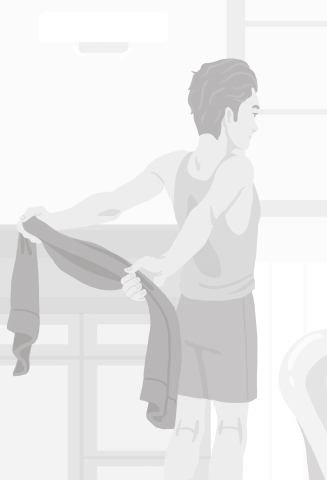
Smartphone Siesta
■ relieve
■ relax
■ calm
■ empower
Seriously. Stop checking your smartphone every two seconds like an itch you can’t stop scratching. Restrain yourself, and consider taking a self-imposed Smartphone Siesta instead. People around the world who take siestas regularly seem to be pretty relaxed and happy, don’t they?
Happy-Go-Yoga
1. Sit on your couch. Kick off your shoes. Wiggle your toes.
2. Take your phone in both hands and put it behind your head.
3. Rest the back of your head on the phone, preferably with a pillow in between the phone and your head.
4. Relax your shoulders.
5. Lean back, and widen your elbows.
6. Close your eyes.
7. Inhale smoothly through your nose.
8. Exhale, and make an mmm sound, like a bee.
9. Keep the phone behind your head and repeat steps 7 and 8 at least ten times.
About Smartphone Siesta
Even if you don’t feel particularly stressed, constantly staring into a small screen with endless amounts of data is registered by your body and mind as a form of effort, and even stress. Happy-Go-Yoga’s Smartphone Siesta combines part of a pose called Supported Headstand (Salamba Sirsasana: suh-LAHM-buh shrr-SHAH-suh-nuh) with one of the most calming breathing techniques in all of yoga. You’re not going to do a headstand in this pose, but the arm shape you use to keep the phone behind your head is a wider version of the base of a supported headstand. In yoga, Headstand is among the more grounding ways of going upside down. The mmm sound is part of Bee Breath (Brahmari Pranayama: BRAH-muh-ree PRAH-nuh-YAH-muh), meant to calm and pacify despite external noise. You get physical relief with the stretch across your chest and upper back as your elbows reach wider. The more you hum, the deeper you’ll go into relaxation. That empowered feeling? It comes from making the choice to break from your smartphone and chill out instead.
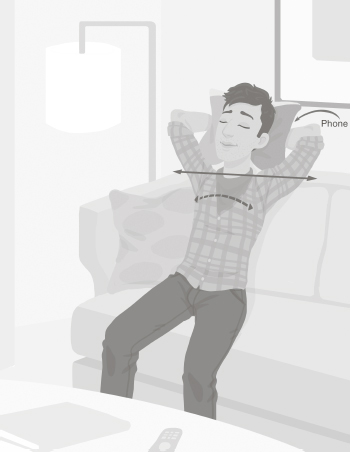
Couch Potato
■ de-stress
■ relax
■ relieve
It’s all you want right now… to curl up on the couch and be a potato. The remote is in your hand, but stop. That cop show, reality cooking competition, or political thriller can wait for a Happy-Go-Yoga moment of total relaxation before you stimulate your brain all over again. Best part? You don’t even have to get off the couch.
Happy-Go-Yoga
1. Lie down on the couch.
2. Scoot your rear end close to the corner of the couch (near the spot where the arm comes down to meet the seat cushion).
3. Gently toss your legs over the arm of the couch.
4. Adjust the distance of your rear from the corner so that this is comfortable. (Your knees will bend close to a ninety-degree angle, but not quite.)
5. Let your arms rest along your sides, with palms facing up, or on your tummy, with palms facing down.
6. Close your eyes. If you’d like, lay a small towel over your eyes so there’s no light coming into them.
7. Inhale and exhale deeply, freeing your mind of junky thoughts each time you exhale.
8. Imagine you’re a dense potato, and sink deeper into the couch.
9. Repeat steps 6 through 8 for about three minutes. Start with one minute if three seems like a lot. In fact, you don’t have to measure how long you stay here, but try not to fall asleep in this position. Stay a tiny bit aware and awake as you rest and let go of the day.
About Couch Potato
Believe it: It takes a good amount of effort to let your body and mind fully release. Happy-Go-Yoga’s Couch Potato is adapted from a classic Restorative yoga pose known as Legs Up The Wall (Viparita Karani: VEE-puh-REE-tuh kuh-RON-ee). Couch Potato helps circulation, relieves tired or cramped legs and feet, and relieves tightness in your hips and lower back. It can also release the back of your neck and calm your mind. Restorative yoga is all about setting up the circumstances and environment to relieve the body of tension and restore energy. In this case, your comfy couch will do just fine.
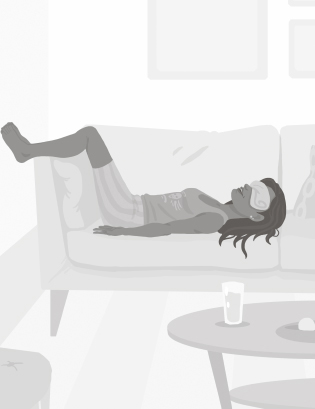
X-tra R&R
■ relieve
■ relax
Now that you’ve done the work to make your home cozy, clean, and comfortable, you need an ultimate way to chill. Lie on your bed, a blanket, or your newly clean carpet and unwind by sprawling out into a big X shape. X-actly what you deserve.
Happy-Go-Yoga
1. Lie down. Inhale and exhale deeply a few times to get comfortable.
2. Inhale. Then exhale and hug yourself into a little ball, hugging your knees to your chin and chest.
3. While still in the ball, inhale easily.
4. Exhale, and release the entire body, letting your arms and legs make an X shape.
5. Inhale easily through the nose.
6. Exhale through your mouth with a big sigh.
7. Repeat steps 2 through 6 a few times as needed to feel like you’re melting into the floor.
8. As you repeat the steps, feel your muscles and bones getting heavier. As you breathe, scan the body for any areas where you are holding tension or gripping. With each exhale, sigh out the tension and soften everything.
About X-tra R&R
There’s a difference between chilling out and really chilling out. A Yin yoga pose called Pentacle is the inspiration for Happy-Go-Yoga’s X-tra R&R. By making an X shape with the body, and pairing it with specific, extra-relieving inhales and exhales, you allow your limbs and torso to fully relax. It only gets better if your mind can let go, too. X-tra R&R gently stretches the tissues that form joints. This pose is not about stretching tight muscles, but about being receptive to letting the body rehabilitate its hardworking cells and organs. In other words, X-tra R&R is like giving your body the break it deserves, and that’s just X-cellent for your health, period.
